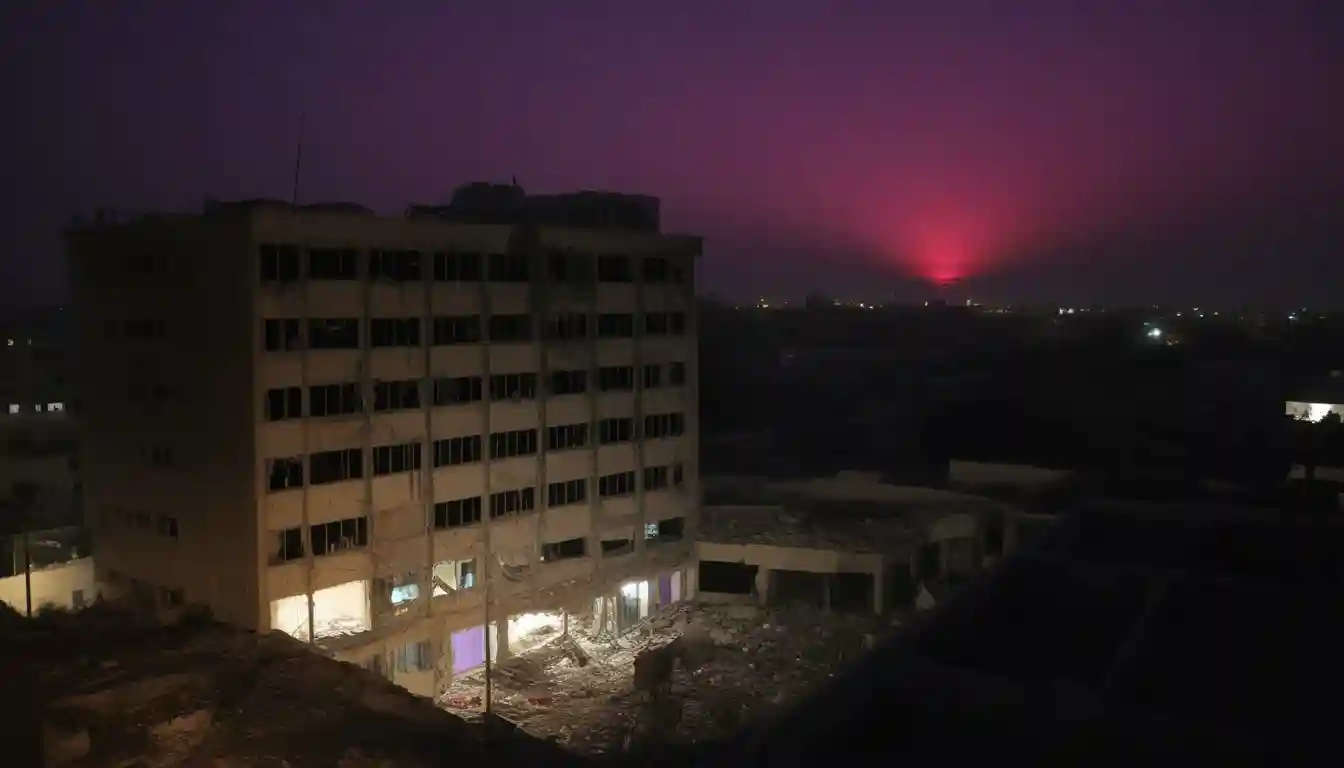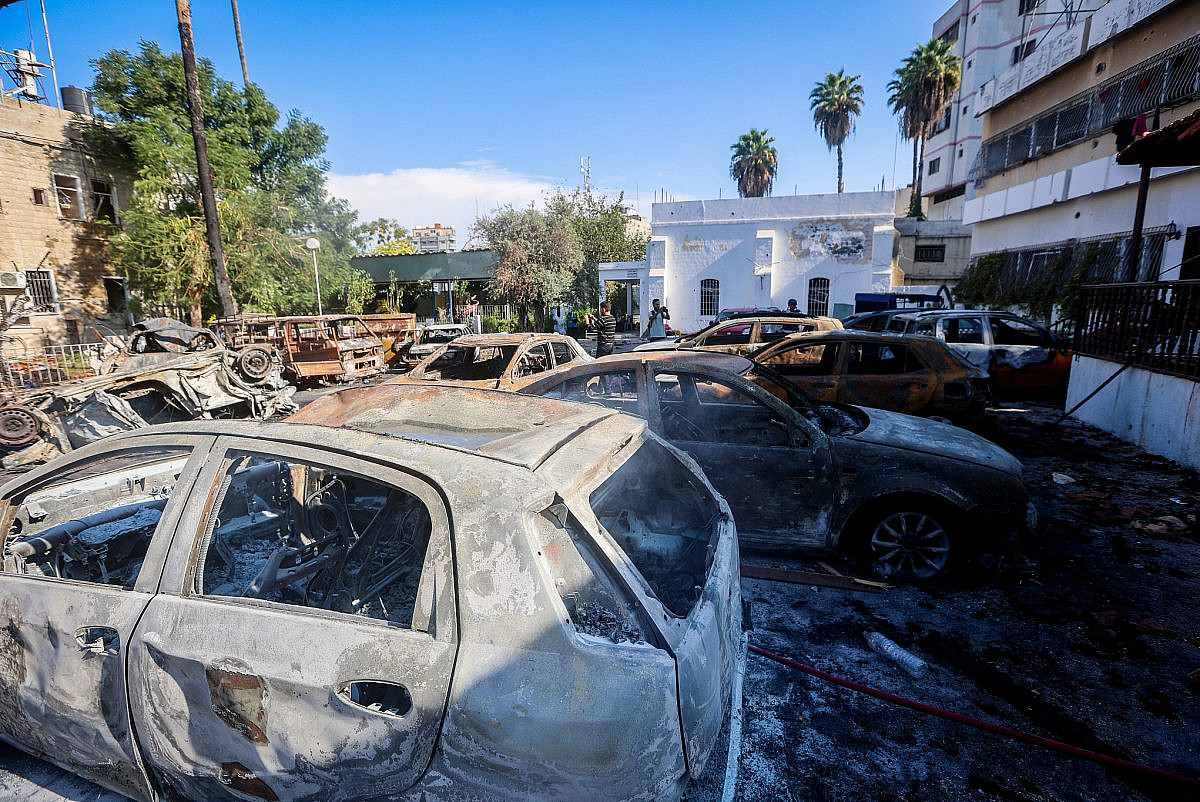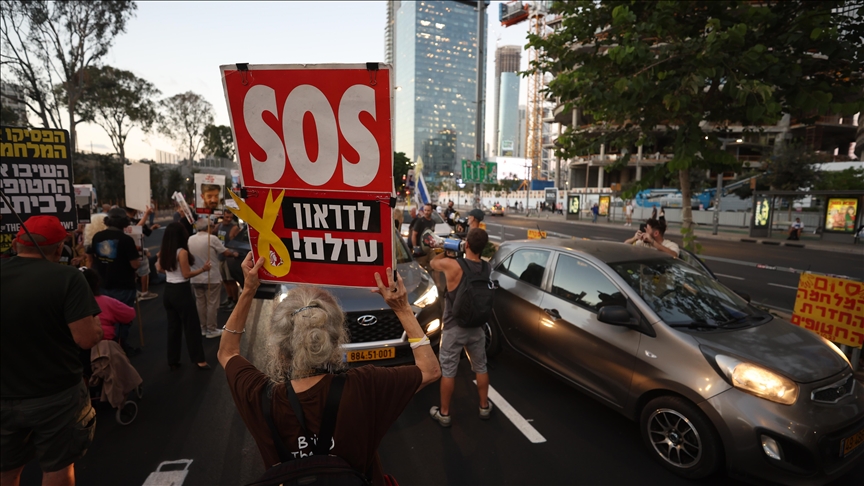
Gaza Hospital Strike Kills Another Seven as Israel Plans Mass Relocations While Markets Ignore Growing Crisis
Gaza Crisis: When Markets Mispriced War's True Cost
Financial markets are underestimating the cascading risks as Israel prepares mass relocations amid mounting international isolation
GAZA CITY — August 17, the al-Ahli Hospital became another casualty in what analysts are calling the most systematically destructive phase of a conflict that has already claimed over 61,800 lives. Seven more died in the airstrike, adding to a daily toll that has averaged 60-120 deaths as Israel prepares its most ambitious military operation yet: the forced relocation of hundreds of thousands of Palestinians to southern "safe zones."

But while humanitarian organizations sound alarm bells over what they term a looming famine that has already killed 251 people from starvation—including 108 children—global markets remain remarkably sanguine. Israel's TA-35 index hovers near record highs, credit default swaps have tightened to 76-108 basis points, and oil prices have retreated from their June peaks despite a regional powder keg that industry veterans say is more volatile than at any point since the 1973 oil crisis.
This disconnect between escalating on-ground realities and market pricing represents more than a temporary misjudgment—it signals a fundamental misunderstanding of how modern warfare, international law, and economic interdependence have reshaped the risk calculus for investors.
Israel's TA-35 stock index performance shows resilience, diverging from the escalating geopolitical and humanitarian crisis on the ground.
| Date / Period | TA-35 Index Performance | Israel 5-Year CDS (Basis Points) | Brent Crude Oil Price (USD per barrel) |
|---|---|---|---|
| Late 2024 | The TA-125 index, a broader measure of the Israeli stock market, surged by 27% for the year, outperforming global peers. | Peaked at 159.60 on October 25, 2024, before declining. | The U.S. Energy Information Administration (EIA) forecast an average of $87 for 2024. |
| March 2025 | The index "swung wildly" amid fears of a ceasefire collapse. | Spreads were elevated, reflecting investor concerns over regional conflict. | Pushed above $90 due to scarcity pressure and supply chain disruptions in the region. |
| June 2025 | Showed resilience, with a 1.5% gain on June 23, contributing to a 20.3% year-to-date rise for the broader TA-125 index. | Rose to 107 bps on June 12 due to escalating regional tensions, but declined to around 200 bps following a ceasefire with Iran. | J.P. Morgan forecast an average of $66 for 2025, citing supply-demand dynamics pointing to lower prices. |
| July-August 2025 | Experienced a temporary 1% decline on July 14 amid military operations, but rebounded with a 1.42% rise on August 10. | Declined to a low of 72.69 by mid-August, indicating reduced immediate default risk. | Crude oil was trading at $63.14 on August 15, with Brent for October delivery at $66.59 on August 10. |
The Arithmetic of Displacement
Israel's plan to evacuate Gaza City's remaining population southward ahead of what military officials describe as a three-month siege represents an operation of staggering complexity. Current estimates suggest 400,000-500,000 civilians would need relocation to areas already hosting 1.7 million displaced persons in conditions that international observers describe as catastrophic.

The logistics alone tell a story of institutional breakdown. UN relief agencies report that airdropped aid—a last resort measure—has itself become deadly, with documented cases of civilians crushed by falling packages or killed in stampedes around drop zones. Recent incidents have forced aid organizations to suspend operations in multiple locations, creating what one senior humanitarian official, speaking on condition of anonymity, called "a perfect storm of man-made famine."
These dynamics carry immediate market implications that traditional risk models have yet to capture. The suspension of all U.S. visitor visas for Gazans, including medical evacuees, signals a hardening of policy positions that could prefigure broader economic restrictions. European Union members, led by Germany's partial arms export suspension, are incrementally tightening military trade relationships that underpin Israel's defense industrial base.
When Legal Pressure Becomes Economic Reality
The International Criminal Court's arrest warrants for Prime Minister Benjamin Netanyahu and former Defense Minister Yoav Gallant—upheld after Israel's failed July appeal—represent more than symbolic legal pressure. They create practical constraints that markets have not yet priced into Israeli sovereign risk.
Travel restrictions for senior officials complicate diplomatic engagement at precisely the moment when regional tensions with Iran remain at hair-trigger sensitivity. The June 12-day Israel-Iran conflict, while ending in ceasefire, established new escalation thresholds that make current Red Sea shipping disruptions a preview of far larger supply chain vulnerabilities.
A Credit Default Swap (CDS) is a financial derivative that acts like an insurance policy, allowing an investor to hedge against the risk of a borrower defaulting on their debt. The cost of this insurance, known as the CDS spread, serves as a direct measure of perceived credit risk. A low or "tight" spread indicates the market sees a low risk of default, while a high spread signals a greater perceived risk for that entity, including for sovereign nations.
Insurance markets, typically the most sensitive barometers of real risk, tell a more sobering story than equity indices. War-risk premiums for Red Sea transit have jumped back toward 0.7% of hull value following renewed Houthi attacks, while the global LNG market faces persistent supply uncertainty due to Israel's offshore gas infrastructure vulnerability.
The Protest Economy
Inside Israel, the largest nationwide protests since October 2023 reflect a political crisis that extends beyond traditional security concerns. Families of the approximately 50 remaining hostages—with only 20 believed alive—are demanding immediate ceasefire negotiations, creating domestic pressure that complicates Netanyahu's "total military victory" strategy.

This internal discord carries profound economic implications. Israel's technology sector, which generates over 18% of GDP, depends heavily on international partnerships that become increasingly difficult to maintain under current legal and diplomatic constraints. The brain drain accelerating among tech professionals represents a structural shift that standard economic metrics fail to capture.
Several industry analysts, speaking anonymously due to the sensitivity of current conditions, suggest that the disconnect between market resilience and operational reality reflects incomplete information flow rather than fundamental confidence. Portfolio managers increasingly rely on algorithmic models that struggle to quantify the economic impact of international legal proceedings and their interaction with geopolitical risk.
The Regional Contagion Vector
Israel's August 17 strikes on Houthi positions near Sanaa underscore how local conflicts generate global economic consequences through interconnected supply chains. The Suez Canal, which handles roughly 15% of global shipping traffic, faces persistent disruption as Yemen-based groups maintain their solidarity campaign with Gaza.
War-risk insurance premiums for transit through the Red Sea have spiked, reflecting the real economic cost of regional instability on global shipping.
| Metric | Latest Data | Previous Data | Cost Comparison |
|---|---|---|---|
| War Risk Insurance Premium | Increased to 0.7% - 1% of a vessel's value in July 2025. | Rose from 0.1% to 0.7-1% of a ship's value in March 2024. | A premium of 1% on a $100 million vessel adds $1 million to the voyage cost. |
| Suez Canal Monthly Traffic | In July 2024, 1,047 ships transited the canal, a 51.5% decrease from July 2023. | In May 2024, 1,111 ships crossed, down from 2,396 in May 2023. | For a tanker, the Suez Canal transit fee is about $500,000, while the extra fuel cost to reroute around Africa is approximately $250,000. |
| Impact on Shipping | Container ship arrivals in the Gulf of Aden were down 90% from the 2023 average in early 2024. | Journeys through the Suez Canal dropped by 42% year-on-year in early 2024. | Rerouting around Africa adds about two weeks to a voyage and can increase fuel costs by $500,000 to $750,000 per trip. |
Energy markets, despite recent price moderation, remain vulnerable to rapid repricing. Israel's $35 billion Leviathan-to-Egypt gas export agreement creates new dependencies that could amplify regional supply shocks. During June's Israel-Iran escalation, production shutdowns demonstrated how quickly energy infrastructure becomes a strategic target.
The broader Middle East gas market, already tight due to ongoing conflicts in Syria and Iraq, lacks the spare capacity to absorb sustained disruptions. European buyers, still adapting to post-Russian supply chains, face particular vulnerability to Mediterranean energy interruptions.
Misreading the Risk Landscape
Current market pricing appears to reflect an assumption that the Gaza conflict remains geographically contained and diplomatically manageable. This assessment overlooks three critical factors reshaping the investment environment:
First, the unprecedented scale of legal accountability mechanisms creates new categories of sovereign risk that existing models cannot properly evaluate. ICC proceedings against sitting government officials represent uncharted territory for sovereign debt and equity markets.
Second, the humanitarian crisis has reached thresholds that trigger automatic policy reviews in allied nations. Germany's arms export restrictions, implemented despite strong bilateral defense relationships, indicate how quickly economic partnerships can shift when public pressure intersects with legal obligations.
Third, the protest movements within Israel signal political instability that could fundamentally alter the country's strategic direction. Coalition governments facing sustained domestic opposition often experience rapid policy reversals that catch markets unprepared.
Sovereign risk is measured by evaluating key factors for investors, such as a country's geopolitical stability and its adherence to international law. The perceived level of this risk directly influences financial indicators like the nation's bond yields, signaling its creditworthiness to the global market.
Investment Implications and Forward Positioning
For institutional investors, the current environment suggests defensive positioning across multiple asset classes. War-risk insurance providers and shipping companies with alternative routing capabilities offer exposure to supply chain premiums without direct geopolitical exposure.
Defense contractors focused on air defense systems, electronic warfare, and cybersecurity may benefit from sustained regional tensions, while companies exposed to arms export licensing face increasing regulatory scrutiny. The energy sector presents mixed signals—LNG logistics and storage infrastructure benefit from supply uncertainty, while upstream producers face operational risk in contested regions.
Israeli equities with significant USD revenue streams provide currency hedging against potential shekel volatility, while domestic-focused sectors face pressure from both fiscal constraints and demographic uncertainty as skilled emigration accelerates.
The most immediate catalyst for market repricing would be a verified 60-day ceasefire with substantive hostage releases and humanitarian access improvements. Conversely, mass casualty events at designated safe zones or successful attacks on critical infrastructure could trigger rapid risk premium adjustments that current positioning appears unprepared to absorb.
As global markets navigate an increasingly complex intersection of warfare, international law, and economic interdependence, the Gaza crisis may prove to be the stress test that reveals how thoroughly traditional risk assessment has been overtaken by new realities.
NOT INVESTMENT ADVICE